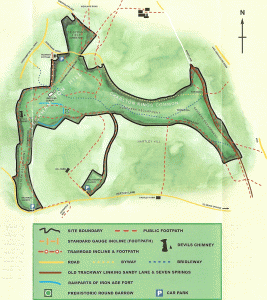What is special about Leckhampton Hill and Charlton Kings Common?
- It is wild countryside at the edge of Cheltenham; an impressive backdrop to Leckhampton and Charlton Kings.
- It is popular with walkers, runners, dog owners, off-road cyclists, naturalists and others.
- It has been owned by Cheltenham Borough Council since 1927 to ensure public access for the future.
- It has unique views of Cheltenham, the Severn Valley, the Malvern Hills and into Wales.
- It has rare plants, animals and geology. It is a Site of Special Scientific Interest (SSSI).
- It has archaeology dating from the Iron Age and important geology.
The following is taken from Cheltenham Borough Council leaflet ‘Leckhampton Hill Local Nature Reserve’.
Outstanding Natural Beauty
Leckhampton Hill and Charlton Kings Common are situated on the edge of the escarpment, within the Cotswold Area of Outstanding Natural Beauty (AONB): most of these 67 hectares (165 acres) are Registered Common Land. Owing to its nationally important geology and grassland, much of the site is protected as a Site of Special Scientific Interest (SSSI). All are welcome to enjoy its ‘wild’ natural environment, history and spectacular views.
The rocks exposed in the quarries are a 70 metre thick section of Jurassic limestone which extends along the Cotswold escarpment. They are important nationally for the fossils they contain and the evidence of the past conditions and processes which formed them. The rocks are formed of compressed sediment laid down at the bottom of a shallow sea some 170 to 175 million years ago.
Cotswold unimproved limestone grassland with its many associated plants and animals has been created over hundreds of years of grazing. After the grazing ceased, scrub and woodland developed, smothering areas of grassland and obscuring views. Restoration with a regime of scrub management, hay cutting and cattle grazing will help to increase the wildflowers, such as Common Rock Rose, Wild Thyme, Autumn Gentian and several species of Orchid. The grassland includes many plants that are scarce at local, county and national level.
Amazing Diverse Habitats
The site supports a large variety of insects with a total of 33 butterfly species recorded, including Marbled White, Dark Green Fritillary, Chalk-hill Blue and the uncommon Duke of Burgundy. There are many moth species and in most summers the strange green light of Glow-worms can be seen after dark. Large Roman Snails are very noticeable in warm damp weather.
Many mammals and reptiles can be found here and they use different habitats according to the way they feed and the shelter they need. Wood Mice, Field Voles, Grey Squirrels, Rabbits and Roe and Muntjac Deer feed on plants in the area, whilst carnivores include Foxes, Shrews, Hedgehogs, Moles, Bats and Badgers. Reptiles such as Slow Worms, Common Lizards and Adders are found on the open hillsides.
The area provides amazingly diverse habitats that support a wide range of bird species. Summer visitors include Chiffchaffs, Willow Warblers, Grasshopper Warblers and Tree Pipits. Some of the all year round residents are Yellowhammers, Bullfinches, Linnets, Goldcrests and both Green and Great Spottted Woodpeckers. Flocks of Redwings and Fieldfares are present in winter. Birds of prey include Buzzard, Sparrowhawk and Kestrel.
Historical Importance
Today’s landscape is the direct result of thousands of years of shaping by humans to meet their changing needs. The Iron Age Hill Fort – Leckhampton Camp – and the adjacent barrow tell of its use as a place of settlement and burial in pre-history. The Camp and barrow are of national archaeological importance and are protected as a Scheduled Ancient Monument.
The Romans extracted stone from the site and in the medieval period it was a sheep run. The inclined tramroads and railways, limekilns and other workings including the famous ‘Devil’s Chimney‘, which give the scarp edge its character today, are a reminder of the centuries of stone quarrying and lime production. More recently a building was erected on the top of the Hill and used for military defence purposes during the Second World War.
Ownership
The entire site is owned by Cheltenham Borough Council – Cheltenham Town Council purchased Leckhampton Hill in 1927 following riots over public access in 1902 and 1906. Charlton Kings Common was transferred from Charlton Kings Urban District Council in 1965.
The Council manages the Site in partnership with the Friends of Leckhampton Hill and Charlton Kings Common (FOLK) with the support of various other local community groups.
Where to next?
If you would like to learn more about the above aspects related to the Hill and Common please look at the following sub-pages.
